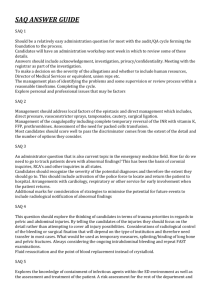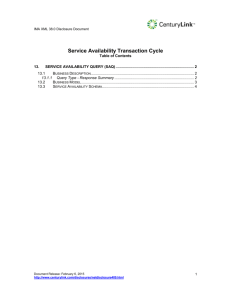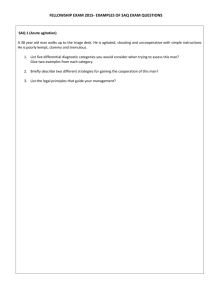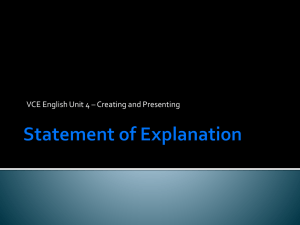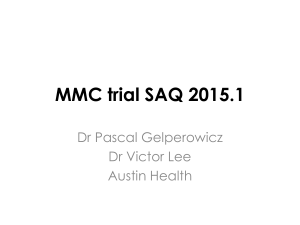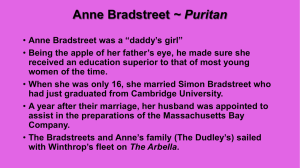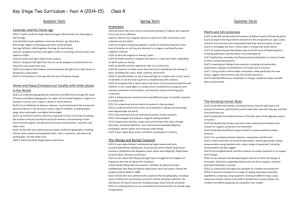PowerPoint
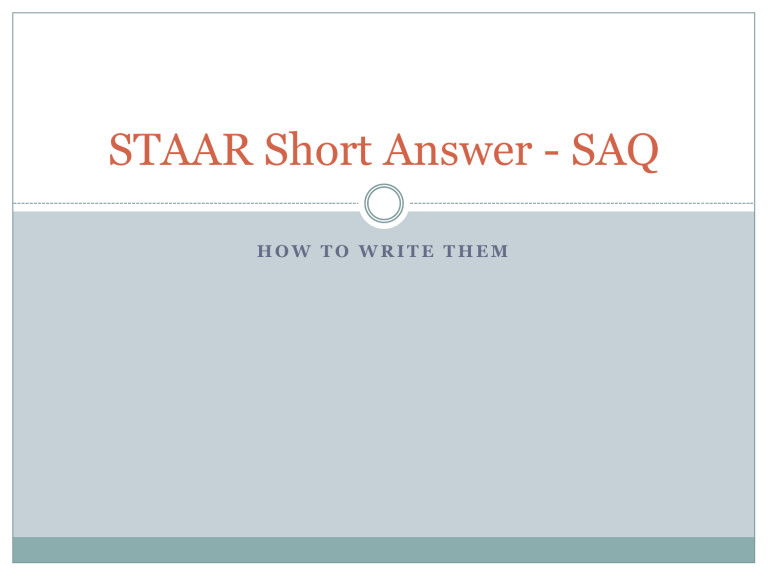
STAAR Short Answer - SAQ
H O W T O W R I T E T H E M
STAAR SAQ Overview
Two short answer reading questions on each English assessment
Each short answer reading question based on a 0 −3 rubric and weighted by 3, for a total of 9 points
A total of 56 points on reading test: short answer questions worth 18 points (32% of total score); multiple choice worth 38 points (68% of total score)
Students have 10 lines to answer each question: 9
“light lines” plus the heavy “border line” at the bottom of the box
Text Evidence
Students must know that text evidence is always flawed when it is only a general reference to the text too partial to support the idea weakly linked to the idea used inappropriately because it wrongly manipulates the meaning of the text
Students must know that to score a 2 or 3 on short answer reading, text evidence must be considered accurate and relevant (SP 2) or specific and well chosen
(SP 3)
SAQ Example Question
English I short answer question for single selection: drama
In this excerpt from Anne of Green Gables , do you think the stage directions enhance your understanding of the scene?
Explain your answer and support it with evidence from the selection.
SAQ Example Response
Example #1 of SP 1 (partially sufficient): idea is specific but text evidence is only a general reference.
In “Anne of Green Gables” I believe the stage directions enhance the understanding of the scene. Some evidence to prove it is all of the first paragraph. It enhances the understanding of the scene by introducing the main character, setting the scene, and setting the mood. Without the stage directions it’s all confusing. Some more text evidence is all of paragraph 8. It enhances the scene by introducing a man who is to adopt Anne and what his character is like. In conclusion I believe the stage directions enhance the scene because without them it’s very confusing. (Response is 7 lines handwritten.)
SAQ Example Response #2
Example #2 of SP 1 (partially sufficient): idea is specific but text evidence is only weakly linked to the idea
Yes it does enhance my understanding, it describes
Anne to me. It lets me know that she’s waiting for something or someone and that she might be unfortunate. “The child wears a too-large overcoat.”
Response is 5 lines handwritten.
SAQ Example Response #3
Example of SP 2 (sufficient): idea is specific and text evidence is relevant and accurate
The stage directions help a lot because you can create better pictures in your head about what is going on. When the story says “[Anne clutches her bag. She is terrified]” shows Anne is scared without Anne having to say it.
Response is 5 lines handwritten.
SAQ Example Response #4
Example of SP 3 (exemplary): idea is perceptive and text evidence is specific and well chosen.
The stage directions most definitely help to get an image of the scene in the play. In a short story or novel, authors use words to describe the setting that the characters are in, which helps to paint a visual image in the reader’s mind.
Descriptions like “a small figure, a child, sits on a battered suitcase” and directions as to who a character is turned talking to like “to Anne” help the reader see what is happening, just like descriptions in a novel or short story.
The reader can definitely see the play being acted out in their minds, which helps them to understand the scenes better and connect with the characters just by reading.
(Response is 9 lines handwritten.)
Developing Ideas
Students must know that an idea is only partially sufficient when it needs more explanation or specificity represents only a literal reading of the text
Students must know that to score a 2 or 3 on short answer reading, the idea(s) must be reasonable, specific, and go beyond a literal reading of the text
(SP 2) or be perceptive, coherent, and discerning
(SP 3).
SAQ Example
English II short answer question for paired selections: poetry and literary nonfiction
How are the themes of “Those Winter Sundays” and “All
My Babies are Gone Now” similar? Support your answer with evidence from both selections.
SAQ Exemplary Response
Example of SP 3 (exemplary): idea is perceptive and text evidence is specific and well chosen.
Both themes are similar in the sense that both the child and mother in the selections have a feeling of remorse of not being able to appreciate who they have in front of them and not being able to take advantage of time. “No one ever thanked him.” The child acknowledges the fact that his father “with cracked hands that ached from labor” would wake up “in the blue black cold” to provide warmth for his family, yet no one seems to be grateful for it. Time flew by for this mother; she didn’t get to cherish her three treasures as she wanted because in the blink of an eye they turned into “three almost adults”.
Response is 8 lines handwritten .
TDEC – Formatting SAQs
T – thesis/topic sentence
D – detail
E – elaborate
C - commentary
T – thesis/topic sentence
Focuses on subject of that paragraph or essay
Answers the question posed
Usually includes the title of the passage/text and the author’s name
Thesis – appears in the first paragraph of an essay
Topic Sentence – appears as the first sentence of a body paragraph or short answer response
D - detail
Provide a quote from the text to support thesis/topic sentence
Can be a full sentence or part of a sentence but must be in quotation marks and must give the page or paragraph number in parenthesis after the end quotes
E - elaborate
Answers “How?” the detail relates back to the topic sentence
Explains the detail for the reader and provides the context of the quote
Expansion of detail
C - commentary
“Why?”
Why did the author write it – reveals the deeper meaning through insight
Does not repeat the elaboration provides an overarching message or what the reader learned
